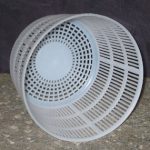
When it comes to cream cheese, there’s nothing like the homemade kind. It is more delicious than even the most popular store brand. The superb flavor of homemade cream cheese comes from quality ingredients.
Did you know that when you make cream cheese at home using a recipe that calls for cheese cultures, you can even tweak the flavor to suit your taste? Make it mild or aromatic (and slightly sharper) — it’s entirely up to you! The flavor just depends on which of the recommended cheese cultures you choose.
We have two cream cheese recipes for you. The first , Creole Cream Cheese, is a unique, regional creation from New Orleans. This cheese has been a long-held tradition in the Big Easy, where folks enjoy it for breakfast, either sprinkled with sugar, or salt and pepper; or, topped with fruit. This recipe comes from a cookbook with a very interesting history. It’s called Cooking Up a Storm, and you can read more about it here.
Our second offering is Jerri’s own recipe for Homesteader’s Supply Easy Cream Cheese. It’s very easy to make, just like the name says. Once you try this recipe, you’ll never again want to buy a commercial brand of cream cheese from the grocery store!
Creole Cream Cheese
This cream cheese recipe is very easy to make at home. At Homesteader’s Supply, we carry special cheese molds, called Brosse molds, which work perfectly for recipes like this one which require draining the whey from the curd.
Ingredients
1 gallon skim milk, between 70 – 80 degrees F
¼ cup cultured buttermilk
½ tsp. liquid rennet
Half-and-half or heavy cream for serving
Directions
- Pour the milk into a large container.
- Add buttermilk and stir the mixture well.
- Then, pour in the rennet and stir vigorously for 1 minute.
(Note: Remember to dilute the rennet with ¼ cup non-chlorinated water 15 minutes prior to use.) - Do not stir again; otherwise, you will disturb the formation of the cheese.
- Cover the container and let stand at room temperature for 12 to 15 hours. All the while, the rennet will be converting the milk solids to a caked (cheese) form. Remember, the longer it stands, the firmer the cheese will be.
- After the cheese has set, ladle it into creole cream cheese molds or other perforated containers, so that the liquid (whey) can drain off the cheese. Place the molds in a large roasting pan on an elevated rack. Then place the set-up in the refrigerator.
- Leave the pan in the refrigerator until no more liquid (whey) drips from the cheese. It will take at least 4 to 6 hours to form. The cream cheese will keep in your refrigerator for at least one month (in clean containers).
- When ready to serve, spoon the cream cheese into bowls, and cover with either half-and-half or heavy cream. Sprinkle with sugar, or salt and pepper; or, top with fruit.
Homesteader’s Supply Easy Cream Cheese
Ingredients
1 gallon of whole milk (from cows, goats, or sheep)
¼ tsp of Biena Meso II -OR- ¼ tsp Biena Meso B (an aromatic culture that makes a sharper flavored cheese)
¼ tsp liquid rennet -OR- ½ tablet vegetarian rennet
Directions
- Pour the milk into a large pot and warm to 75 degrees F.
- Remove the pot from the stove. Then, add the cheese culture. Allow it to dissolve on top of the milk for 30 seconds, and then stir thoroughly.
- Add the dissolved rennet mixture to the milk mixture and stir thoroughly.
(Note: Always dilute liquid rennet, or dissolve rennet tablets, in ¼ cup non-chlorinated water for 15 minutes prior to use.) - Pour the milk mixture into a container (such as a plastic or glass jar), and seal it with lid. (Note: You can use a Yogotherm yogurt maker for this part of the process, but remember the container in the Yogotherm only holds ½ gallon.)
- Place the container where it can remain at room temperature for 12 to 16 hours.
- Then, pour the contents of the container into a cheesecloth-lined colander sitting on top of a bowl. Place a plate, or another type of cover, on top to help maintain the temperature. This allows the liquid whey to drain away from the cheese curd.
- Place this set-up where it can remain at room temperature for 8 to 12 hours. You can check the consistency of the cheese every so often. Closer to 8 hours will result in moister cheese; leave it longer if you want a drier cheese that will crumble like Feta.
- When the consistency is to your liking, scrape the cheese from the cloth into a bowl. Then, mix in salt, herbs, fresh juice from fruit, or whatever else you would like to use to flavor your cheese. You can make several flavors by placing smaller amounts into several containers and flavoring each one differently.
Now you have a healthy and flavorful, spreadable cream cheese for bread or crackers. Or, if you like, you even eat it with a spoon. Just place some in a bowl and add cream, nuts, herbs, fruit, or whatever toppings or flavoring you desire.
Have you ever tried making cream cheese at home? Tell us about your experiences in the comments section at the bottom of this page.

